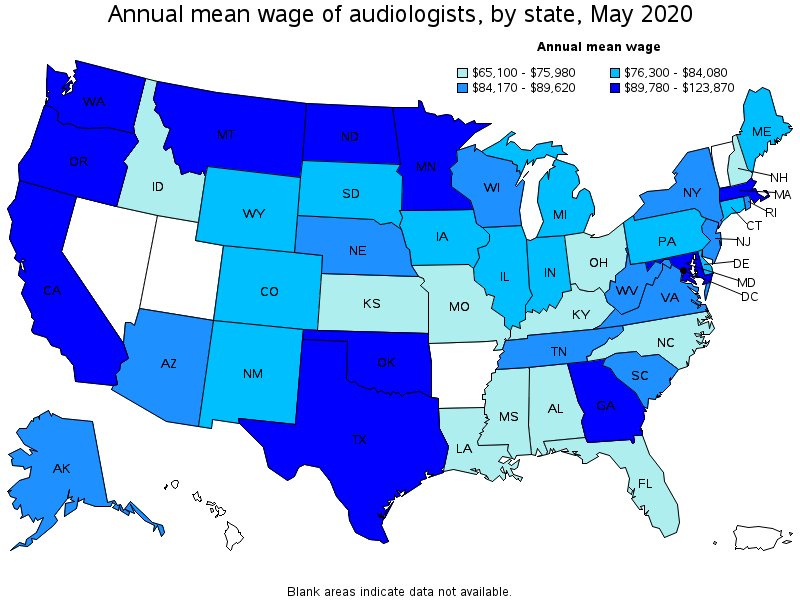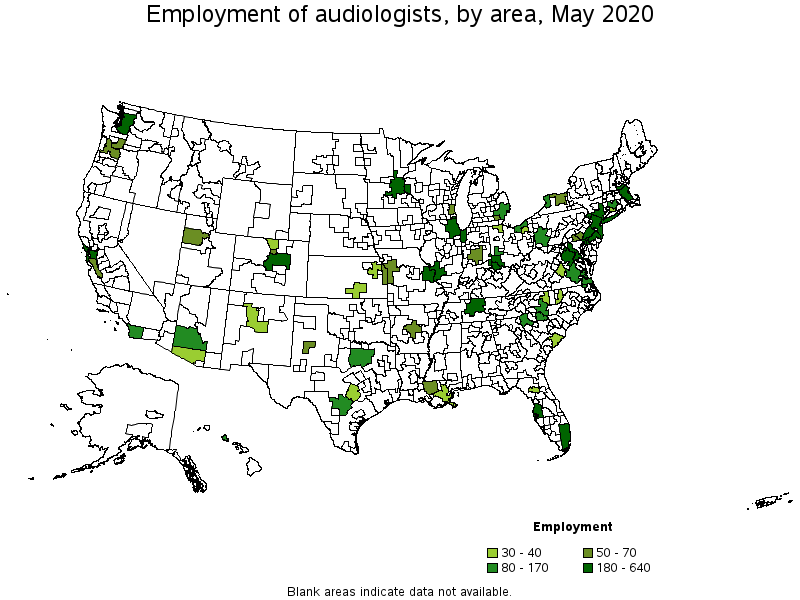An official website of the United States government
 United States Department of Labor
United States Department of Labor
Assess and treat persons with hearing and related disorders. May fit hearing aids and provide auditory training. May perform research related to hearing problems.
Employment estimate and mean wage estimates for Audiologists:
| Employment (1) | Employment RSE (3) |
Mean hourly wage |
Mean annual wage (2) |
Wage RSE (3) |
|---|---|---|---|---|
| 13,300 | 4.9 % | $ 42.90 | $ 89,230 | 2.2 % |
Percentile wage estimates for Audiologists:
| Percentile | 10% | 25% | 50% (Median) |
75% | 90% |
|---|---|---|---|---|---|
| Hourly Wage | $ 27.19 | $ 33.15 | $ 38.95 | $ 49.14 | $ 61.62 |
| Annual Wage (2) | $ 56,550 | $ 68,940 | $ 81,030 | $ 102,220 | $ 128,160 |
Industries with the highest published employment and wages for Audiologists are provided. For a list of all industries with employment in Audiologists, see the Create Customized Tables function.
Industries with the highest levels of employment in Audiologists:
| Industry | Employment (1) | Percent of industry employment | Hourly mean wage | Annual mean wage (2) |
|---|---|---|---|---|
| Offices of Physicians | 3,580 | 0.14 | $ 42.52 | $ 88,450 |
| Offices of Other Health Practitioners | 3,320 | 0.37 | $ 44.80 | $ 93,170 |
| General Medical and Surgical Hospitals | 1,870 | 0.03 | $ 41.86 | $ 87,080 |
| Health and Personal Care Stores | 1,480 | 0.15 | $ 41.01 | $ 85,290 |
| Elementary and Secondary Schools | 850 | 0.01 | $ 43.59 | $ 90,670 |
Industries with the highest concentration of employment in Audiologists:
| Industry | Employment (1) | Percent of industry employment | Hourly mean wage | Annual mean wage (2) |
|---|---|---|---|---|
| Offices of Other Health Practitioners | 3,320 | 0.37 | $ 44.80 | $ 93,170 |
| Health and Personal Care Stores | 1,480 | 0.15 | $ 41.01 | $ 85,290 |
| Offices of Physicians | 3,580 | 0.14 | $ 42.52 | $ 88,450 |
| Other Ambulatory Health Care Services | 320 | 0.10 | $ 33.80 | $ 70,300 |
| Educational Support Services | 160 | 0.08 | $ 35.65 | $ 74,140 |
Top paying industries for Audiologists:
| Industry | Employment (1) | Percent of industry employment | Hourly mean wage | Annual mean wage (2) |
|---|---|---|---|---|
| Outpatient Care Centers | 570 | 0.06 | $ 51.20 | $ 106,500 |
| Local Government, excluding schools and hospitals (OEWS Designation) | 80 | (7) | $ 45.49 | $ 94,620 |
| Offices of Other Health Practitioners | 3,320 | 0.37 | $ 44.80 | $ 93,170 |
| Navigational, Measuring, Electromedical, and Control Instruments Manufacturing | 160 | 0.04 | $ 43.86 | $ 91,230 |
| Elementary and Secondary Schools | 850 | 0.01 | $ 43.59 | $ 90,670 |
States and areas with the highest published employment, location quotients, and wages for Audiologists are provided. For a list of all areas with employment in Audiologists, see the Create Customized Tables function.

States with the highest employment level in Audiologists:
| State | Employment (1) | Employment per thousand jobs | Location quotient (9) | Hourly mean wage | Annual mean wage (2) |
|---|---|---|---|---|---|
| California | 1,340 | 0.08 | 0.85 | $ 55.55 | $ 115,540 |
| Ohio | 960 | 0.19 | 1.94 | $ 35.37 | $ 73,580 |
| Florida | 800 | 0.09 | 0.99 | $ 35.46 | $ 73,760 |
| New York | 760 | 0.09 | 0.91 | $ 41.14 | $ 85,580 |
| Texas | 660 | 0.05 | 0.57 | $ 43.70 | $ 90,900 |

States with the highest concentration of jobs and location quotients in Audiologists:
| State | Employment (1) | Employment per thousand jobs | Location quotient (9) | Hourly mean wage | Annual mean wage (2) |
|---|---|---|---|---|---|
| Ohio | 960 | 0.19 | 1.94 | $ 35.37 | $ 73,580 |
| West Virginia | 110 | 0.16 | 1.71 | $ 42.23 | $ 87,840 |
| Hawaii | 90 | 0.16 | 1.71 | (8) | (8) |
| Idaho | 110 | 0.15 | 1.60 | $ 36.53 | $ 75,980 |
| Tennessee | 430 | 0.15 | 1.55 | $ 42.44 | $ 88,270 |

Top paying states for Audiologists:
| State | Employment (1) | Employment per thousand jobs | Location quotient (9) | Hourly mean wage | Annual mean wage (2) |
|---|---|---|---|---|---|
| North Dakota | 30 | 0.08 | 0.79 | $ 59.55 | $ 123,870 |
| California | 1,340 | 0.08 | 0.85 | $ 55.55 | $ 115,540 |
| Maryland | (8) | (8) | (8) | $ 50.06 | $ 104,130 |
| Oklahoma | 80 | 0.05 | 0.52 | $ 48.95 | $ 101,810 |
| District of Columbia | 100 | 0.14 | 1.47 | $ 46.95 | $ 97,650 |

Metropolitan areas with the highest employment level in Audiologists:
| Metropolitan area | Employment (1) | Employment per thousand jobs | Location quotient (9) | Hourly mean wage | Annual mean wage (2) |
|---|---|---|---|---|---|
| New York-Newark-Jersey City, NY-NJ-PA | 640 | 0.07 | 0.75 | $ 42.98 | $ 89,390 |
| Chicago-Naperville-Elgin, IL-IN-WI | 350 | 0.08 | 0.85 | $ 39.88 | $ 82,940 |
| San Francisco-Oakland-Hayward, CA | 300 | 0.13 | 1.37 | $ 56.90 | $ 118,350 |
| St. Louis, MO-IL | 250 | 0.19 | 2.04 | $ 36.64 | $ 76,210 |
| Denver-Aurora-Lakewood, CO | 230 | 0.16 | 1.67 | $ 36.66 | $ 76,240 |
| Philadelphia-Camden-Wilmington, PA-NJ-DE-MD | 230 | 0.08 | 0.88 | $ 38.58 | $ 80,250 |
| Minneapolis-St. Paul-Bloomington, MN-WI | 220 | 0.12 | 1.24 | $ 44.36 | $ 92,270 |
| Boston-Cambridge-Nashua, MA-NH | 220 | 0.08 | 0.88 | $ 43.94 | $ 91,400 |
| Seattle-Tacoma-Bellevue, WA | 210 | 0.11 | 1.13 | $ 50.44 | $ 104,910 |
| Miami-Fort Lauderdale-West Palm Beach, FL | 200 | 0.08 | 0.82 | $ 40.10 | $ 83,400 |

Metropolitan areas with the highest concentration of jobs and location quotients in Audiologists:
| Metropolitan area | Employment (1) | Employment per thousand jobs | Location quotient (9) | Hourly mean wage | Annual mean wage (2) |
|---|---|---|---|---|---|
| Topeka, KS | 40 | 0.38 | 4.02 | $ 35.76 | $ 74,380 |
| Boulder, CO | 70 | 0.37 | 3.83 | $ 42.63 | $ 88,670 |
| Charlottesville, VA | 40 | 0.34 | 3.58 | $ 34.88 | $ 72,550 |
| Lubbock, TX | 50 | 0.33 | 3.47 | $ 45.39 | $ 94,420 |
| York-Hanover, PA | 50 | 0.28 | 2.96 | (8) | (8) |
| Greenville-Anderson-Mauldin, SC | 110 | 0.27 | 2.85 | $ 46.36 | $ 96,420 |
| Gainesville, FL | 40 | 0.26 | 2.70 | $ 41.41 | $ 86,120 |
| Virginia Beach-Norfolk-Newport News, VA-NC | 170 | 0.24 | 2.51 | $ 44.07 | $ 91,660 |
| Dayton, OH | 80 | 0.24 | 2.48 | $ 33.45 | $ 69,570 |
| Lancaster, PA | 50 | 0.23 | 2.44 | $ 44.54 | $ 92,650 |

Top paying metropolitan areas for Audiologists:
| Metropolitan area | Employment (1) | Employment per thousand jobs | Location quotient (9) | Hourly mean wage | Annual mean wage (2) |
|---|---|---|---|---|---|
| Reno, NV | (8) | (8) | (8) | $ 72.82 | $ 151,460 |
| Tulsa, OK | (8) | (8) | (8) | $ 61.83 | $ 128,620 |
| Little Rock-North Little Rock-Conway, AR | 50 | 0.16 | 1.68 | $ 61.16 | $ 127,210 |
| San Jose-Sunnyvale-Santa Clara, CA | 70 | 0.06 | 0.64 | $ 57.48 | $ 119,550 |
| Los Angeles-Long Beach-Anaheim, CA | (8) | (8) | (8) | $ 57.41 | $ 119,420 |
| San Francisco-Oakland-Hayward, CA | 300 | 0.13 | 1.37 | $ 56.90 | $ 118,350 |
| Vallejo-Fairfield, CA | (8) | (8) | (8) | $ 55.04 | $ 114,490 |
| Eugene, OR | (8) | (8) | (8) | $ 52.33 | $ 108,850 |
| Sacramento--Roseville--Arden-Arcade, CA | (8) | (8) | (8) | $ 51.48 | $ 107,070 |
| Seattle-Tacoma-Bellevue, WA | 210 | 0.11 | 1.13 | $ 50.44 | $ 104,910 |
These estimates are calculated with data collected from employers in all industry sectors, all metropolitan and nonmetropolitan areas, and all states and the District of Columbia. The top employment and wage figures are provided above. The complete list is available in the downloadable XLS files.
The percentile wage estimate is the value of a wage below which a certain percent of workers fall. The median wage is the 50th percentile wage estimate—50 percent of workers earn less than the median and 50 percent of workers earn more than the median. More about percentile wages.
(1) Estimates for detailed occupations do not sum to the totals because the totals include occupations not shown separately. Estimates do not include self-employed workers.
(2) Annual wages have been calculated by multiplying the hourly mean wage by a "year-round, full-time" hours figure of 2,080 hours; for those occupations where there is not an hourly wage published, the annual wage has been directly calculated from the reported survey data.
(3) The relative standard error (RSE) is a measure of the reliability of a survey statistic. The smaller the relative standard error, the more precise the estimate.
(7) The value is less than .005 percent of industry employment.
(8) Estimate not released.
(9) The location quotient is the ratio of the area concentration of occupational employment to the national average concentration. A location quotient greater than one indicates the occupation has a higher share of employment than average, and a location quotient less than one indicates the occupation is less prevalent in the area than average.
Other OEWS estimates and related information:
May 2020 National Occupational Employment and Wage Estimates
May 2020 State Occupational Employment and Wage Estimates
May 2020 Metropolitan and Nonmetropolitan Area Occupational Employment and Wage Estimates
May 2020 National Industry-Specific Occupational Employment and Wage Estimates
Last Modified Date: March 31, 2021